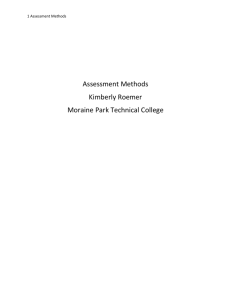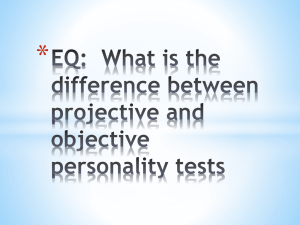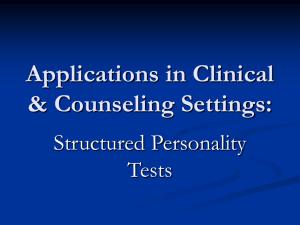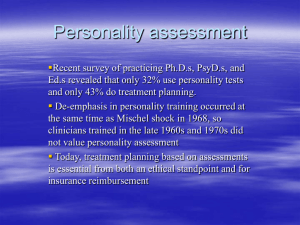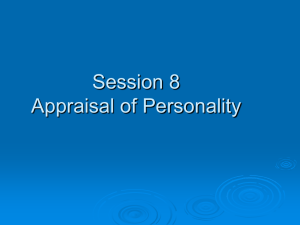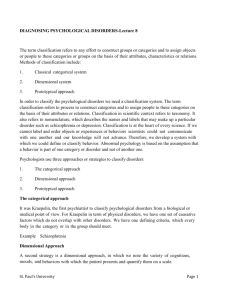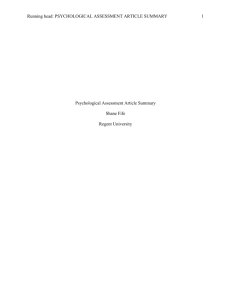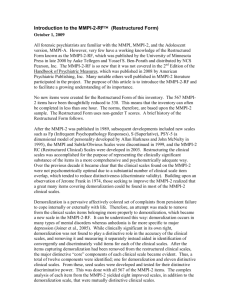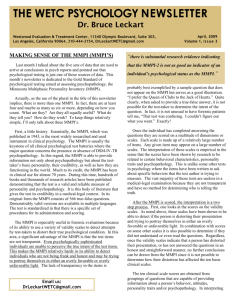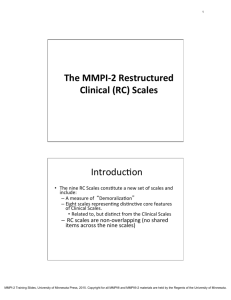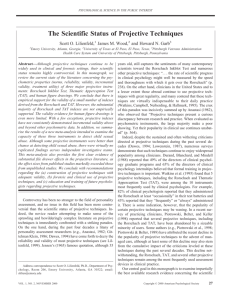Chapter 8
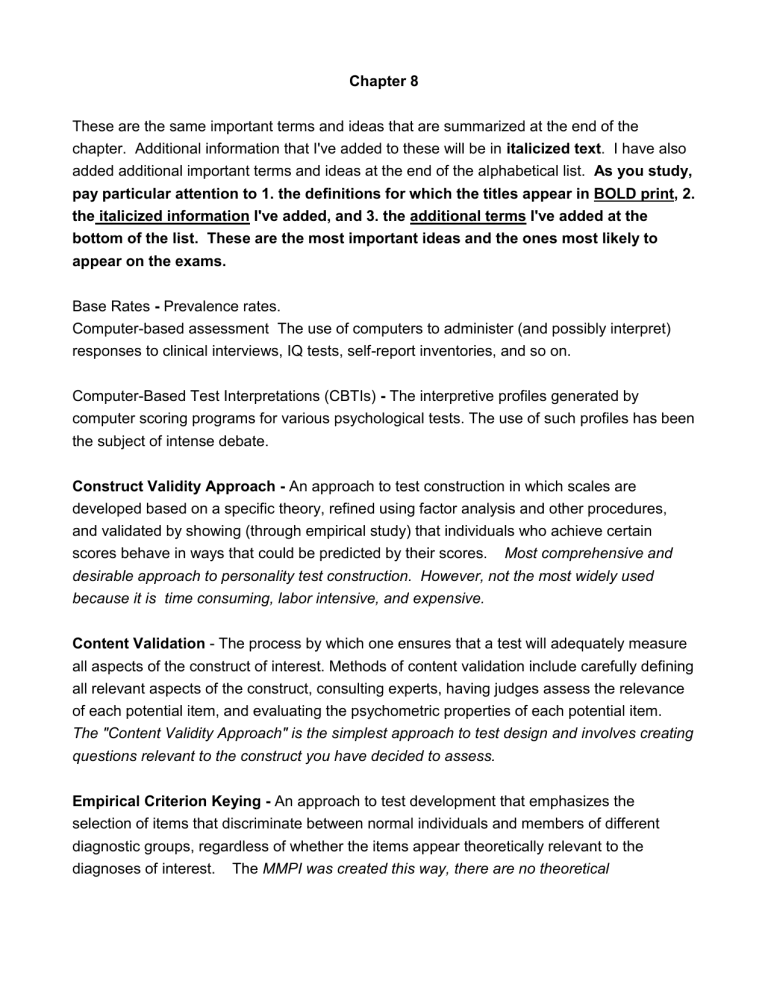
Chapter 8
These are the same important terms and ideas that are summarized at the end of the chapter. Additional information that I've added to these will be in italicized text . I have also added additional important terms and ideas at the end of the alphabetical list. As you study, pay particular attention to 1. the definitions for which the titles appear in BOLD print, 2. the italicized information I've added, and 3. the additional terms I've added at the bottom of the list.
These are the most important ideas and the ones most likely to appear on the exams.
Base Rates Prevalence rates.
Computer-based assessment The use of computers to administer (and possibly interpret) responses to clinical interviews, IQ tests, self-report inventories, and so on.
Computer-Based Test Interpretations (CBTIs) The interpretive profiles generated by computer scoring programs for various psychological tests. The use of such profiles has been the subject of intense debate.
Construct Validity Approach An approach to test construction in which scales are developed based on a specific theory, refined using factor analysis and other procedures, and validated by showing (through empirical study) that individuals who achieve certain scores behave in ways that could be predicted by their scores. Most comprehensive and desirable approach to personality test construction. However, not the most widely used because it is time consuming, labor intensive, and expensive.
Content Validation - The process by which one ensures that a test will adequately measure all aspects of the construct of interest. Methods of content validation include carefully defining all relevant aspects of the construct, consulting experts, having judges assess the relevance of each potential item, and evaluating the psychometric properties of each potential item.
The "Content Validity Approach" is the simplest approach to test design and involves creating questions relevant to the construct you have decided to assess.
Empirical Criterion Keying An approach to test development that emphasizes the selection of items that discriminate between normal individuals and members of different diagnostic groups, regardless of whether the items appear theoretically relevant to the diagnoses of interest. The MMPI was created this way, there are no theoretical
assumptions made (atheoretical), If most members of a diagnostic group (e.g., depressives) endorse a statement e.g., (I feel tired )then that will be a good “depression question”
Factor Analytic Approach A statistical method often used in test construction to determine whether potential items are or are not highly related to each other. Currently, the most popular approach to test construction. Exploratory factor analysis mines data for what factors might be there. Confirmatory factor analysis sees if the factor structure of questions agrees
with the theory they were based on. The construct validity approach is preferable but time and cost make it less practical.
Five-Factor Model (FFM) A comprehensive model of personality that comprises the dimensions of Neuroticism, Extraversion, Openness, Agreeableness, and Conscientiousness as well as six facets belonging to each dimension. Currently, the most agreed upon (by psychologists) model of personality.
Illusory Correlation In the context of projective testing, the phenomenon by which certain test responses become associated with specific personality characteristics. These responses come to be viewed as signs of the trait in question and may be given undue weight when interpreting the test. This will most likely be a problem for clinicians using projective tests like the Rorschach. A particular response [man with arm raised] is incorrectly taken to be a sign of a particular trait [violence] based on only one or two instances.
Incomplete Sentences Blank (ISB) The best known and most widely used of the sentence completion techniques, consisting of 40 sentence stems. Developed by Julian Rotter and the most popular sentence completion test. A projective test that uses words instead of pictures.
Incremental Validity The extent to which a scale score provides information about a person's behavior, personality features, or psychopathology features that is not provided by other measures. To be useful a test must provide useful information we don’t
already have. If we have a valid MMPI, we would likely not gain much from a NEO administration.
MMPI-2 A measure of psychopathology that was developed using the empirical criterion keying approach. The MMPI-2 consists of 567 true –false items and provides scores on ten clinical scales, seven validity scales, and several content and supplementary scales.
Interpretation of the MMPI-2 is usually based on an analysis of the entire profile rather than
on selected scores. Like the MMPI before it, the MMPI-2 has been used for many different purposes across multiple settings, and it remains one of the primary self-report inventories of personality and psychopathology. Developed by Hathaway and Mckinley in the 1940s, most widely used and highly respected of all personality tests. With so many questions, it was easy to add new scales (such as the "Family Problems Content Scale" to the original 10 clinical scales.
Objective Personality Measures Personality assessment tools in which the examinee responds to a standard set of questions or statements using a fixed set of options (e.g., true or false, dimensional ratings).
Projective Techniques Psychological testing techniques that use people's responses to ambiguous test stimuli to make judgments about their adjustment –maladjustment.
Proponents believe that examinees "project" themselves onto the stimuli, thus revealing unconscious aspects of themselves. Generally, these are resistant to the application of psychometrics (statistical methods) so reliability and validity have not been demonstrated. Advocates of projectives say that objective tests like the MMPI fail to capture the “motives” and “dynamics” of personality.
Revised NEO-Personality Inventory (NEO-PI-R) A self-report measure of the FFM that consists of 240 statements, each of which is rated on a 5-point scale. This test yields scores on all five domains of the FFM (Neuroticism, Extraversion, Openness, Agreeableness, and
Conscientiousness) as well as the six facets corresponding to each domain. Personality inventory developed by Costa and McCrae, based on the “five factor model,” some advocate its use for diagnosis but Dr. Richman disagrees. It was designed to asse ss “NORMAL” personality and it is doubtful that any amount of change would make it as good as the MMPI for clinical assessment.
Rorschach A projective technique that interprets people's responses to a series of 10 inkblots.
Sentence Completion Method A simple projective technique in which people are asked to complete, in writing, a number of sentence stems (e.g., "I often believe . . ."). See "ISB" above.
Test Bias The situation in which different decisions or predictions are made for members of two groups, even when they obtain the same score on an instrument.
Thematic Apperception Test A projective technique that purports to reveal patients' personality characteristics by interpreting the stories they produce in response to a series of pictures.
Validity Of Cutoff Scores (Thresholds) The extent to which a particular cutoff score accurately classifies people as either possessing or not possessing the disorder or trait in question.
Validity Scales Test scales that attempt to shed light on the respondent's test-taking attitudes and motivations (e.g., to present themselves in an overly favorable light, to exaggerate their problems or symptoms, to engage in random responding).
A strength of
MMPI is its 7 validity scales. Hig h “F” suggests faking bad, high “L” and “K” suggest faking good, TRIN suggests agreeableness, and VRIN suggests random responding (see pg. 213)
Below are some additional ideas and terms from Chapter 8 you should know
Content and Supplementary Scales
– additional scales added to the MMPI’s original
10 clinical scales (ex. family problems (fam)).
John Exner – Developed a comprehensive (and complicated) scoring system for
the Rorschach which is currently the most widely accepted method (see
Profile 8 – 2).
Rorschach vs. TAT – Many clinicians, myself included, have fewer "issues" with the TAT than the Rorschach. It is not nearly as complex and labor intensive. Also, its results seem more straightforward and of practical use.
Compare the example “clinician reports” for the two tests.
MMPI
Patterns or “Profiles” – Based on a person’s highest 2 or 3 clinical scales, are commonly used to interpret the MMPI. See Ed’s profile in Box 8 – 1 and
description. His high 2 scale suggests depression while high 7 suggests
anxiety, high 4 suggests hostility and family problems (high 5 in not of major
importance).

